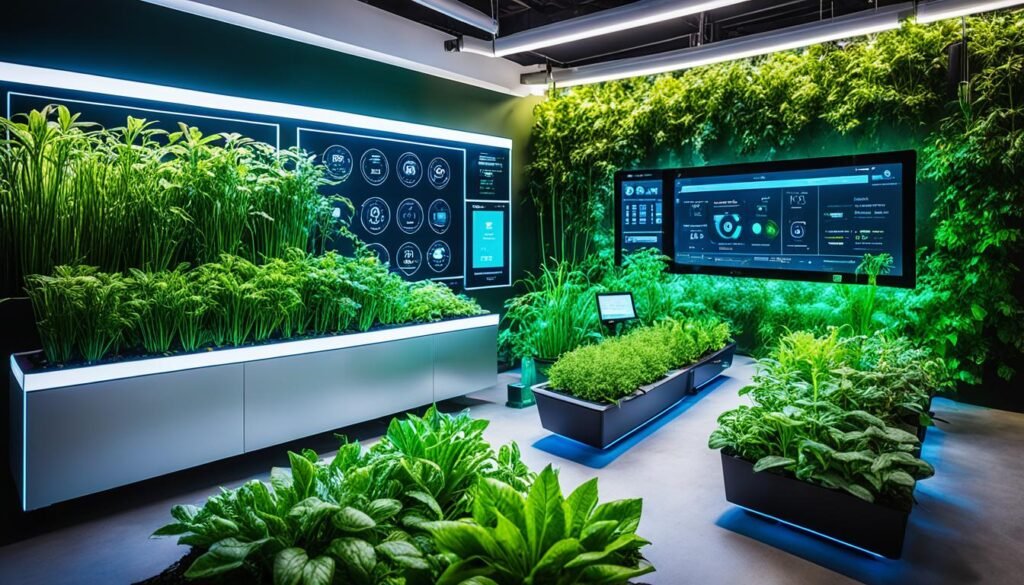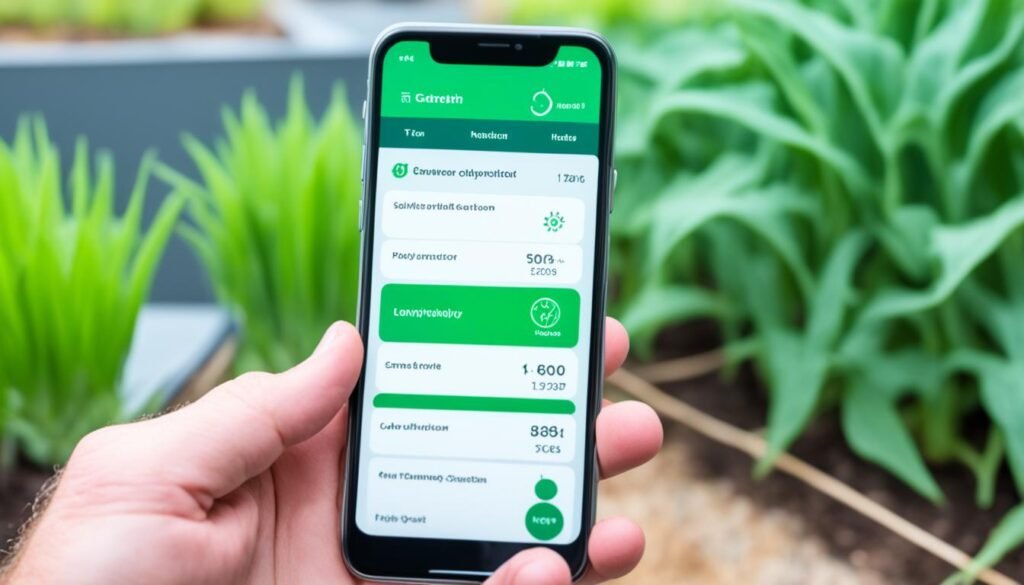Boult Z20 Truly Wireless Bluetooth Ear Buds with 51H Playtime, Zen™ Calling ENC Mic, Made in India, Low Latency Gaming, Touch Controls, Rich Bass Drivers, TWS Earbuds Bluetooth Wireless (Jet Black)
₹999.00 (as of April 24, 2025 21:24 GMT +05:30 - More infoProduct prices and availability are accurate as of the date/time indicated and are subject to change. Any price and availability information displayed on [relevant Amazon Site(s), as applicable] at the time of purchase will apply to the purchase of this product.)Imagine a garden that could take care of itself, adjusting to what your plants need precisely. This is the core of smart gardening. It blends IoT (Internet of Things) tech with gardening know-how. Have you ever thought of how to make a garden smart, even in tough spots?
With IoT sensors and automation, you can make a garden that needs very little maintenance. It will water and adjust the climate for your plants perfectly. Smart gardening uses tech to make watering, lighting, and checking the environment automatic. This makes it simpler to grow plants inside or in small areas. By adding IoT gadgets, gardeners can control their garden from far away. They can also keep an eye on their plant’s health and make sure conditions are just right for the best growth.
Key Takeaways
- Smart gardening uses IoT sensors and automation to create a low-maintenance, productive garden.
- IoT devices enable remote control, monitoring, and optimization of growing conditions for maximum plant productivity.
- Smart gardens automate watering, lighting, and environmental monitoring, making it easier to grow plants indoors or in small spaces.
- Precision irrigation, climate control, and real-time plant monitoring are key features of smart gardens.
- Leveraging IoT technology, smart gardeners can track plant health and optimize growing conditions for their gardens.
Introduction to Smart Gardening
Smart gardening brings IoT technology to our gardens. It uses sensors and automation to make gardens smart. This technology lets us keep an eye on plant health, water and light plants automatically, and adjust conditions for different types of gardening.
What is Smart Gardening?
Smart gardening changes the way we take care of plants. It uses IoT sensors and systems to watch over our gardens from afar. With smart gardening, we can monitor plant health, control water and light, and keep the best environment for our gardens. This works for both indoor and urban garden spaces.
Benefits of Smart Gardens
IoT in gardening has a lot of good things for all gardeners. Smart gardens give us up-to-date info on soil and air, helping us care for plants better. This means healthier plants, more crops, and using less water and power. Smart gardening is both efficient and good for the planet.
Planning Your Smart Garden
Start your journey to a smart garden with careful planning. The right spot and knowing what you want from your garden are key. This leads to a lush, automated indoor paradise. We’ll look at the main things to think about when smart garden planning.
Choosing the Right Location
Your indoor garden location success needs good light, natural or not. Find a place in your living or working space that gets a lot of sun. Or you might need to add quality grow lights. Also, think about how close it is to power, water, and if it’s easy to get to for upkeep.
Determining Your Gardening Needs
Think about what you want from your smart garden. Do you want to grow herbs, veggies, or different plants? And what do you hope to get from it, like how much and how it looks? Figuring out what you need for your smart garden design is important. It lets you pick the right parts and set things up to work best for you.
Essential Components of a Smart Garden
To create a smart garden that thrives, we need several key parts. These include smart soil and planters, special lights, and sensors for moisture and temperature. These tools work together to make gardening more automatic and improve the growth.
Smart Soil and Planters
Smart soil gives plants just what they need to grow strong and healthy. It has special sensors to check the soil’s condition. This helps the garden system give the plants exactly the right care. Smart planters can also change size to fit the plants better as they grow.
Grow Lights and Light Sensors
Plants need good light to grow, especially inside or in low-light places. Advanced grow lights come with sensors. They change the light’s type and amount based on what the plants require to grow well.
Moisture and Temperature Sensors
Keeping an eye on how plants are doing is key. Sensors for moisture and temperature are placed around the garden. They send data to the garden’s “brain.” Then, the system can change the water, heat, or air to keep the plants happy.
How to Create a Smart Garden with IoT

Creating a smart garden with IoT is a step-by-step process. It involves setting up an IoT controller, connecting varied sensors and devices. So, we configure a smart garden app to handle it all. This method helps gardeners automate and perfect their indoor or outdoor gardens. It uses smart garden IoT, sensors, and app configuration to make your garden smart. This way, you can get all the benefits of an IoT garden setup and smart automation.
Setting Up the IoT Controller
The core of your smart garden is the IoT controller. It acts as the brain to talk to all your sensors and devices. You can use a Raspberry Pi, Arduino, or other platforms. They work with the controls, process data, and connect to the web or mobile apps for checking and controlling things from afar.
Connecting Sensors and Devices
For a really smart garden, you must link many sensors and devices. These look after the growing space. You need things like soil moisture sensors, temperature gauges, grow lights, and water pumps. They team up to boost your plants’ health and boost how well they grow. Making sure your sensors are well-linked is key to having your IoT garden work perfectly.
Configuring the Smart Garden App
The last part is getting a mobile app or online platform ready. This is for keeping an eye, control, and automate your garden system. These apps are easy to use for changing watering times, watching plant data, or getting alerts about problems or upkeep needs. Setting up the app right is crucial for reaping the full advantages of your smart garden’s automation.
Automating Your Smart Garden
A smart garden can do lots of tasks on its own, like watering and lighting. The main part of the system is an IoT controller. It uses data from soil moisture sensors and the air to decide when to water plants.
Scheduling Watering and Lighting
The smart garden automation system makes sure plants get the right amount of water. It sets a schedule and changes it as needed, depending on how wet the soil is, or the weather. This avoids over or under-watering your plants.
The system also manages lights for your plants. It turns the lights on and off to copy natural sunlight. This helps your plants do photosynthesis well. With this automated lighting system, you don’t have to change the lights yourself, making it easy to grow plants indoors or in the city.
Remote Monitoring and Control
A smart garden lets you watch over it and control it from far away. The IoT controller connects to an app on your phone or a website. This lets you see how your garden is doing, change the watering and lighting times, and get alerts about problems. With this, you can take care of your garden even when you’re not home.
Maintenance and Troubleshooting

Keeping your smart garden in top shape is key. It helps your plants stay healthy. Clean and change parts like sensor probes, grow lights, and filters often. This keeps your garden working well.
Cleaning and Replacing Components
It’s vital to keep your garden’s parts clean and new for the best results. Clean the sensor probes to remove any dirt. Change grow lights when they get dim. Also, fix or switch out water filters to keep the water clean. This makes sure your garden supports your plants as best as it can.
Diagnosing and Fixing Issues
When something’s wrong with your smart garden, start by finding the problem. Look at sensor data, check the parts, and see if the system’s set right. Issues might be with the sensors, lights, or water. By finding and fixing these problems fast, your garden and plants will be happy again.
It’s crucial to always check and fix your smart garden. This way, it will keep growing well. Cleaning and replacing parts, as well as solving problems, is the key. With some effort, your garden will work perfectly and you’ll see amazing results.
Smart Garden Designs and Layouts
Smart garden designs offer limitless possibilities. They can fit any space, big or small. You can have an indoor garden or a vertical one with the right setup.
Smart gardens look great because of the tech they use. You can make yours modern or natural, just by adding the right tools. Things like sensors and lights can make your garden perfect.
| Smart Garden Design Approach | Key Features | Ideal for |
|---|---|---|
| Compact, Self-Contained Units | – Integrated IoT controller – Automated watering and lighting – Compact, space-saving design | Small spaces, urban environments, indoor garden design |
| Modular, Scalable Systems | – Customizable, expandable layout – Support for vertical gardening and hydroponic gardening – Advanced environmental monitoring and control | Larger spaces, hobby gardeners, commercial growers |
| Nature-Inspired Designs | – Seamless integration of technology – Emphasis on smart garden aesthetics – Incorporation of natural elements | Biophilic design, smart garden layouts for home and office |
Choosing the right smart garden design means using IoT smartly. This makes your garden easy to take care of and beautiful. With the right plan and components, smart gardening adds to your space’s beauty.
Integrating with Other Smart Home Systems
Smart gardens fit well with other smart home parts. They make your home more together and easy to control. When you link your smart garden to your smart home, you get to use both better.
Merging a smart garden with smart home systems means you track and manage lots of home jobs from one place. You can handle lights, the house’s temperature, safety, and watch energy use all at once. This makes your home smarter and simpler for you.
Picture this: your smart garden pairs with a smart thermostat. This makes sure your plants are always in the best temperature and humidity. Also, your garden lights and house lights work together. Your whole home looks and feels nice.
Connecting your smart garden to your home systems kicks up your home’s cleverness. It makes your home amazing by linking your garden to every part of your smart home. This way, you make a living space that really responds and acts smart.
Best Smart Garden Kits and Products
The market for best smart garden kits and top smart garden products has grown a lot. It now has a big variety for gardeners to choose from. They want to make their indoor growing easier and better. Some top items are smart garden systems, smart garden devices, and smart garden automation solutions.
| Product | Features | Price Range |
|---|---|---|
| AeroGarden Harvest Elite | Automated hydroponics, built-in LED grow lights, touchscreen control | $149.95 – $199.95 |
| Click and Grow Smart Garden 9 | Self-watering, smart soil cartridges, app-controlled lighting | $199.95 – $249.95 |
| Gardyn Home | Vertical hydroponic system, AI-powered plant monitoring, mobile app | $799 – $999 |
| Parrot Flower Power | Wireless soil moisture, light, and fertilizer sensors, smartphone app | $59.99 – $99.99 |
The best smart garden kits and top smart garden products have many cool features. They include things like automated hydroponics and self-watering. Others have sensors and apps. This makes it simple to have a great smart garden at home or work.
How to Create a Smart Garden with IoT
Creating a smart garden with IoT is easy if you follow a few steps. You need to plan, set up, and adjust your system for the best results.
- Assess your gardening needs: First, think about your garden’s size and what plants you’ll grow. Also, consider how much light, water, and the right temperature they need.
- Choose the right IoT components: Next, pick an IoT controller like a Raspberry Pi. Add sensors for checking soil moisture, light, and temperature.
- Set up the IoT controller: Then, connect your controller to Wi-Fi and get the right apps. This way, you can control your garden.
- Install the sensors and actuators: Now, place your sensors and devices around your garden. Add items like smart planters, lights, and water systems. Connect these to your controller.
- Configure the smart garden app: After that, set up your app or website. You can check and change your garden’s watering, lighting, and health of plants from here.
- Optimize and maintain your smart garden: Keep an eye on your garden and make changes when needed. Make sure everything works well. This will help your smart garden project stay great.
Just follow these steps to make a guide to smart garden iot. It will help with lots of garden jobs, making your garden look beautiful with less work.
Conclusion
The future of gardening is smart and connected. IoT gardening benefits are clear. Smart garden systems will soon change how we grow plants, inside or in small spaces outside. With indoor gardening with technology, making gardens that need little care, yet produce a lot, is possible.
The advantages of smart gardens keep growing. They can water and light plants automatically. They also check on plant health and the surroundings in real time. This high level of control lets plant lovers make the best conditions for their garden. They can reduce waste and see their smart home gardening flourish. As technology gets better, the future for smart gardens is full of possibilities. It leads to a more eco-friendly and easier way to garden inside or in the city.
With IoT and smart home tech, a new kind of gardening is here. It changes how we take care of our plants with efficiency and data. This helps us help our planet and live more independently. Starting with a smart garden can mix technology with nature. This turns our homes into places where gardens grow well and are good for the Earth.







0 Comments